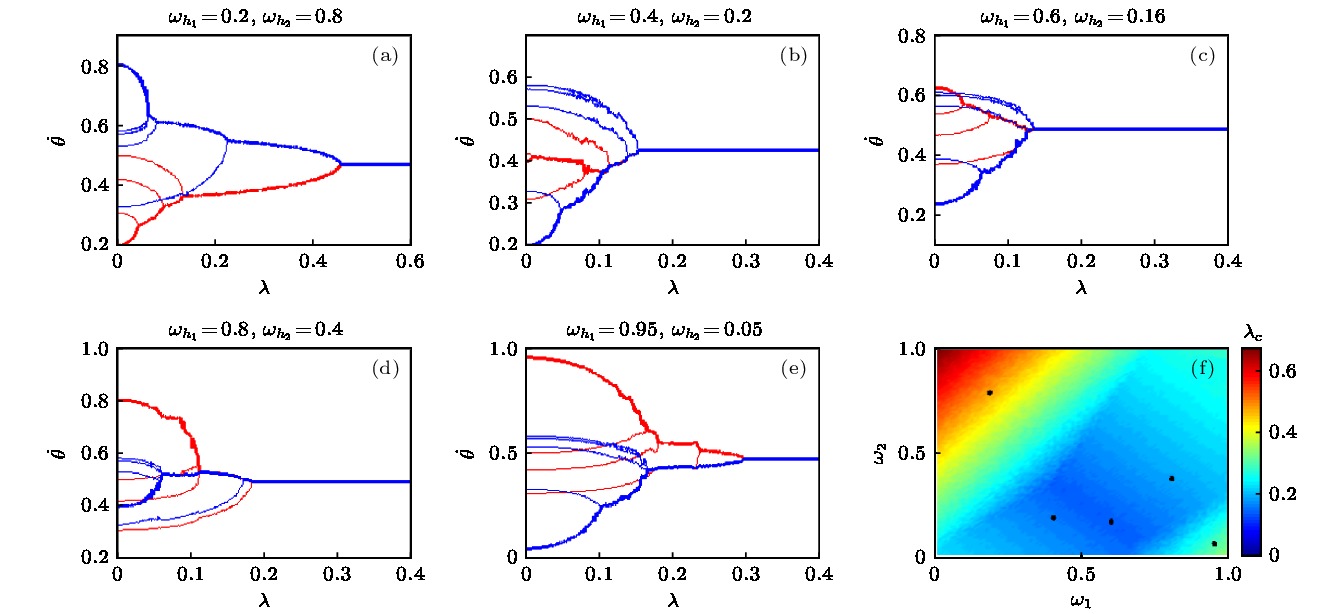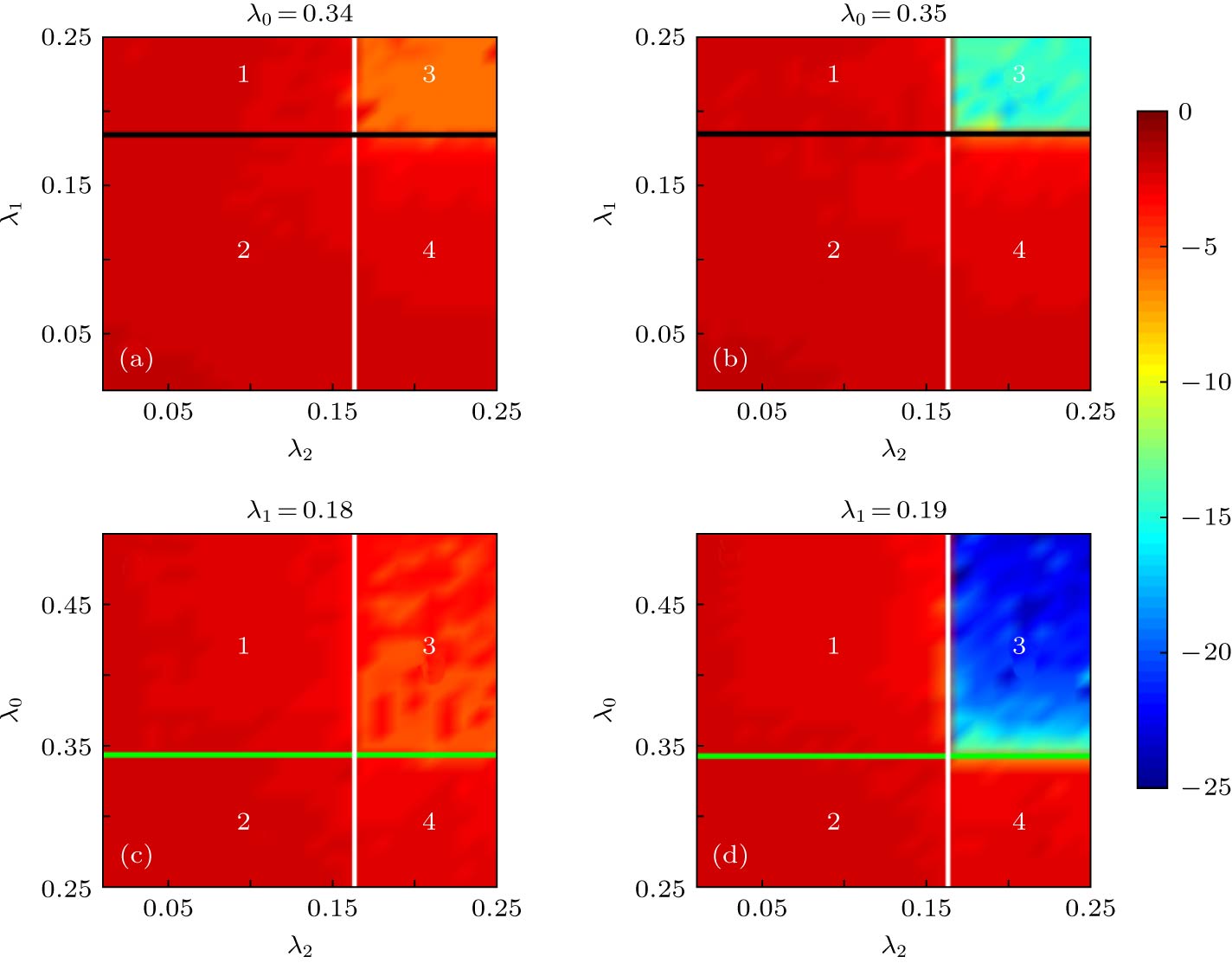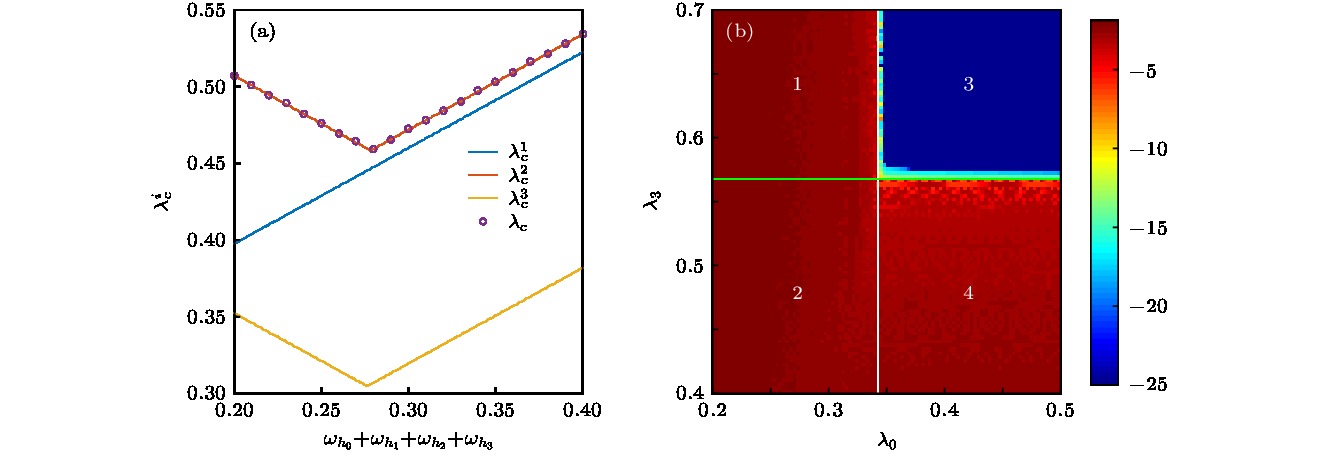-
本文讨论了星型网络中耦合Kuramoto振子的同步优化问题. 分别考察具有随机频率分布叶子节点的单星型结构和多星型结构耦合网络达到同步所需的临界耦合强度. 基于正弦函数的有界性导出的理论结果表明, 单星型结构网络中, 系统同步临界耦合强度与中心振子频率之间具有分段线性关系, 而多星型结构耦合网络中, 系统同步临界耦合强度与所有星型结构中心振子的频率之和保持分段线性关系. 两种结构的网络的同步临界耦合强度最小值均在分段线性的转折点处. 多星型结构耦合网络中, 最小同步临界耦合强度出现在耦合系统只有一个同步集团的情形, 而最大同步临界耦合强度出现在耦合系统有多个同步集团的情形.
-
关键词:
- Kuramoto模型 /
- 星型网络 /
- 同步
In this paper, we discuss the optimization problem of the synchronization for Kuramoto oscillators in coupled star networks. In previous studies of star networks, the natural frequencies of leaf nodes are usually equal or only adjusted within a small parameter range, but this assumption is not satisfied in most of cases. Considering the random distribution of the frequency of the leaf nodes in a single star network and multiple coupled star networks, the critical coupling strength required for system synchronization is obtained according to the boundedness of the sinusoidal function. In a single star network, the piecewise linear relationship between the critical coupling strength of the system and the frequency of the central oscillator is found. In the coupled system of two star networks, we consider that they are coupled through the central node. The parameter plane of the natural frequency of the central node will be divided into different regions. In each region, the critical coupling strength is determined by the coupling strength within the respective star networks or the coupling strength between the two central nodes. Considering the coupling of multiple star networks, we introduce a central connection node through which the central nodes of multiple star networks are coupled. In the above two models of multiple coupled star networks, the piecewise linear relationship between the critical coupling strength of the system and the sum of frequencies of the center oscillators is found. The critical coupling strength of the two types of networks is smallest at the piecewise point. According to the optimization results, we find that with the increase of coupling strength, when there is only one cluster in the system, the critical coupling strength becomes small. So we can reduce the critical coupling strength of the system by adjusting the frequency of the central oscillator for achieving the effect of synchronous optimization. When multiple clusters are generated in the system, the critical coupling strength turns large. Because of the similarity between star network and scale-free network and the application of Kuramoto model in power grid, this paper can provide a good theoretical reference for the further study on synchronization optimization of scale-free network and power grid.-
Keywords:
- Kuramoto model /
- star network /
- synchronization
[1] Boccaletti S, Latora V, Moreno Y, Chavez M, Hwang D U 2006 Phys. Rep. 424 175
 Google Scholar
Google Scholar
[2] Arenas A, Diaz-Guilera A, Kurths J, Moreno Y, Zhou C S 2008 Phys. Rep. 469 93
 Google Scholar
Google Scholar
[3] Osipov G V, Kurths J, Zhou C 2007 Synchronization in Oscillatory Networks (New York: Springer) p368
[4] Gil S, Mikhailov A S 2009 Phys. Rev. E 79 026219
 Google Scholar
Google Scholar
[5] Izhikevich E M 2007 Dynamical Systems in Neuroscience : the Geometry of Excitability and Bursting (Cambridge: MIT Press) p441
[6] Grant M, Elder K R 1999 Phys. Rev. Lett. 82 14
 Google Scholar
Google Scholar
[7] Kuramoto Y 1984 Chemical Oscillations, Waves, and Turbulence (New York: Springer-Verlag) p156
[8] Ullner E, Koseska A, Kurths J, Volkov E, Kantz H, Garcia-Ojalvo J 2008 Phys. Rev. E 78 031904
 Google Scholar
Google Scholar
[9] Donges J F, Zou Y, Marwan N, Kurths J 2009 Eur. Phys. J.-Spec. Top 174 157
 Google Scholar
Google Scholar
[10] Donges J F, Zou Y, Marwan N, Kurths J 2009 Europhys. Lett. 87 48007
 Google Scholar
Google Scholar
[11] Maraun D, Kurths J 2005 Geophys. Res. Lett. 32 L15709 1
[12] Ditto W 2002 Nature 415 736
[13] Wiesenfeld K, Colet P, Strogatz S H 1998 Phys. Rev. E 57 1563
[14] Argyris A, Syvridis D, Larger L, Annovazzi-Lodi V, Colet P, Fischer I, Garcia-Ojalvo J, Mirasso C R, Pesquera L, Shore K A 2005 Nature 438 343
 Google Scholar
Google Scholar
[15] Ermentrout B 1991 J. Math. Biol. 29 571
 Google Scholar
Google Scholar
[16] Vinogradova T M, Lyashkov A E, Zhu W Z, Ruknudin A M, Sirenko S, Yang D M, Deo S, Barlow M, Johnson S, Caffrey J L, Zhou Y Y, Xiao R P, Cheng H P, Stern M D, Maltsev V A, Lakatta E G 2006 Circ. Res. 98 505
 Google Scholar
Google Scholar
[17] Stam C J 2005 Clin. Neurophysiol. 116 2266
 Google Scholar
Google Scholar
[18] Macleod K, Laurent G 1996 Science 274 5289
[19] Prakash M, Gershenfeld N 2007 Science 315 832
 Google Scholar
Google Scholar
[20] Acebron J A, Bonilla L L, Vicente C J P, Ritort F, Spigler R 2005 Rev. Mod. Phys. 77 137
 Google Scholar
Google Scholar
[21] Strogatz S H, Mirollo R E 1988 Physica D 31 143
[22] Zheng Z G, Hu G, Hu B 1998 Phys. Rev. Lett. 81 5318
 Google Scholar
Google Scholar
[23] Bergner A, Frasca M, Sciuto G, Buscarino A, Ngamga E J, Fortuna L, Kurths J 2012 Phys. Rev. E 85 026208
 Google Scholar
Google Scholar
[24] Schmidt R, LaFleur K J R, de Reus M A, van den Berg L H, van den Heuvel M P 2015 BMC Neurosci. 16 54
 Google Scholar
Google Scholar
[25] Nishikawa T, Motter A E, Lai, Y C, Hoppensteadt F C, 2003 Phys. Rev. Lett. 91 014101
 Google Scholar
Google Scholar
[26] Zhang X, Boccaletti S, Guan S, Liu Z 2015 Phys. Rev. Lett. 114 038701
 Google Scholar
Google Scholar
[27] Liu W, Wu Y, Xiao J, Zhan M, 2013 Europhys. Lett. 101 38002
 Google Scholar
Google Scholar
[28] Xu C, Sun Y T, Gao J, Jia W J, Zheng Z G 2018 Nonlinear Dyn. 94 1267
 Google Scholar
Google Scholar
[29] Wang C S, Zou Y, Guan S G, Kurths J 2017 New J. Phys. 19 123036
 Google Scholar
Google Scholar
-
图 2
${\omega _{{j_1}}} = \left[ {0.31,0.42,0.5} \right]$ ,${\omega _{{j_2}}} = \left[ {0.58,0.53,0.57,0.33} \right]$ 情况下的数值计算结果 (a)−(e)不同中心节点频率情况下的节点平均频率随耦合强度的变化, 其中红线和蓝线分别表示(a)−(e)不同中心节点频率情况下的节点平均频率随耦合强度的变化, 其中红线和蓝线分别表示S1和S2的节点, 粗线和细线分别表示中心节点和叶子节点; (f)系统临界耦合强度${\lambda _{\rm{c}}}$ 随${\omega _{{{{h}}_{\rm{1}}}}},{\omega _{{{{h}}_{\rm{2}}}}}$ 值的变化, 越靠近冷色调表示临界耦合强度越小Fig. 2. Numerical results for
${\omega _{{j_1}}} = \left[ {0.31,0.42,0.5} \right]$ ,${\omega _{{j_2}}} = \left[ {0.58,0.53,0.57,0.33} \right]$ . (a)−(e) Average frequency versus coupling strength for two coupled star networks S1 (red) and S2 (blue). The thick and thin lines respectively represent the center nodes and leaf nodes. (f) The critical coupling strength${\lambda _{\rm{c}}}$ versus${\omega _{{{{h}}_{\rm{1}}}}},\;{\omega _{{{{h}}_{\rm{2}}}}}$ . The value of${\lambda _{\rm{c}}}$ is shown according to the colorbar.图 3 (a)−(c)分别表示
$\lambda _{\rm{c}}^{\rm{1}},\lambda _{\rm{c}}^{\rm{2}},\lambda _{\rm{c}}^{\rm{0}}$ 随${\omega _{{{{h}}_{\rm{1}}}}},{\omega _{{{{h}}_{{2}}}}}$ 值的变化情况; (d)${\lambda _{\rm{c}}}$ 随${\omega _{{{{h}}_{\rm{1}}}}},{\omega _{{{{h}}_{\rm{2}}}}}$ 值的变化情况,${\lambda _{\rm{c}}} = \max \{ \lambda _{\rm{c}}^1,\lambda _{\rm{c}}^2,\lambda _{\rm{c}}^0\} $ ,${\omega _{{{{h}}_{\rm{1}}}}},{\omega _{{{{h}}_{\rm{2}}}}}$ 参数平面被分为不同的区域, 两条红线表示$\lambda _{\rm{c}}^{\rm{1}}$ 与$\lambda _{\rm{c}}^{\rm{0}}$ 相等的区域, 两条黑线表示$\lambda _{\rm{c}}^{\rm{0}}$ 与$\lambda _{\rm{c}}^{\rm{2}}$ 相等的区域, 白线表示$\lambda _{\rm{c}}^{\rm{1}}$ 与$\lambda _{\rm{c}}^{\rm{2}}$ 相等的区域Fig. 3. (a)−(c)
$\lambda _{\rm{c}}^{\rm{1}},\lambda _{\rm{c}}^{\rm{2}},\lambda _{\rm{c}}^{\rm{0}}$ versus${\omega _{{{{h}}_{\rm{1}}}}},{\omega _{{{{h}}_{\rm{2}}}}}$ . (d)${\lambda _{\rm{c}}}$ versus${\omega _{{{{h}}_{\rm{1}}}}},{\omega _{{{{h}}_{\rm{2}}}}}$ , where${\lambda _{\rm{c}}} = \max \{ \lambda _{\rm{c}}^1,\lambda _{\rm{c}}^2,\lambda _{\rm{c}}^0\} $ ; the parameter space can be divided into different regions according to the value of${\lambda _{\rm{c}}}$ ; the red lines denote$\lambda _{\rm{c}}^{\rm{1}} = \lambda _{\rm{c}}^{\rm{0}}$ ; the black lines denote$\lambda _{\rm{c}}^{\rm{2}} = \lambda _{\rm{c}}^{\rm{0}}$ ; the white lines denote$\lambda _{\rm{c}}^{\rm{1}} = \lambda _{\rm{c}}^{\rm{2}}$ .图 5
${\omega _{{{{h}}_1}}} = 0.4,{\omega _{{{{h}}_2}}} = 0.8$ 时, 不同耦合强度参数区间下, 节点平均频率的方差的对数值 (a)${\lambda _0} < \lambda _{\rm{c}}^{\rm{0}}$ ; (b)${\lambda _0}> \lambda _{\rm{c}}^{\rm{0}}$ ; (c)$ {\lambda _1} < \lambda _{\rm{c}}^1$ ; (d)${\lambda _1} > \lambda _{\rm{c}}^1$ , 颜色越靠近冷色调表示系统的同步程度越高, 黑线、白线、绿线分别表示理论推导出的$\lambda _{\rm{c}}^1$ ,$\lambda _{\rm{c}}^2$ ,$\lambda _{\rm{c}}^0$ Fig. 5. Logarithmic variance of average frequency in parameter space of coupling strength for
${\omega _{{{{h}}_{\rm{1}}}}} = 0.4,{\omega _{{{{h}}_{\rm{2}}}}} = 0.8$ : (a)${\lambda _0} < \lambda _{\rm{c}}^{\rm{0}}$ ; (b)${\lambda _0} > \lambda _{\rm{c}}^{\rm{0}}$ ; (c)${\lambda _1} < \lambda _{\rm{c}}^1$ ; (d)${\lambda _1} > \lambda _{\rm{c}}^1$ . The smaller logarithmic variance of average frequency indicates better synchronization. Black line, white line and green line represent the theoretical critical coupling strength for synchroniation$\lambda _{\rm{c}}^1$ ,$\lambda _{\rm{c}}^2$ ,$\lambda _{\rm{c}}^0$ , respectively.图 6 参数为
${\omega _{{j_1}}} = \left[ {0.27,\;0.05,\;0.10} \right],\;{\omega _{{j_2}}} = \left[ {0.69,\;0.31,\;0.84,\;0.95,\;0.03} \right],\;{\omega _{{j_3}}} = $ [0.77, 0.80, 0.19, 0.49]时的数值计算结果 (a)控制所有耦合强度相等时, 系统的同步临界耦合强度随${\omega _{{{{h}}_i}}}$ 的和的关系图, 数值计算结果如圆圈所示, 理论推导结果如实线所示; (b)当固定${\lambda _1} = 0.41,\;{\lambda _2} = 0.5$ , 改变参数${\lambda _3},\;{\lambda _0}$ 时, 所有节点平均频率的方差的对数结果, 绿线和白线分别是理论得到的$\lambda _{\rm{c}}^{\rm{0}},\;\lambda _{\rm{c}}^{\rm{3}}$ Fig. 6. Numerical results and theoretical results for
${\omega _{{j_1}}} = \left[ {0.27,\;0.05,\;0.10} \right]$ ,${\omega _{{j_2}}} = \left[ {0.69,\;0.31,\;0.84,\;0.95,\;0.03} \right]$ ,${\omega _{{j_3}}} = $ [0.77, 0.80, 0.19, 0.49]: (a) The critical coupling strength for synchronization versus the summation of central node frequencies; the numerical results are shown in the circle and the theoretical ones are shown in the solid lines; (b) the logarithmic variance of average frequency in parameter space of${\lambda _3},{\lambda _0}$ for given${\lambda _1} = 0.41,{\lambda _2} = 0.5$ . -
[1] Boccaletti S, Latora V, Moreno Y, Chavez M, Hwang D U 2006 Phys. Rep. 424 175
 Google Scholar
Google Scholar
[2] Arenas A, Diaz-Guilera A, Kurths J, Moreno Y, Zhou C S 2008 Phys. Rep. 469 93
 Google Scholar
Google Scholar
[3] Osipov G V, Kurths J, Zhou C 2007 Synchronization in Oscillatory Networks (New York: Springer) p368
[4] Gil S, Mikhailov A S 2009 Phys. Rev. E 79 026219
 Google Scholar
Google Scholar
[5] Izhikevich E M 2007 Dynamical Systems in Neuroscience : the Geometry of Excitability and Bursting (Cambridge: MIT Press) p441
[6] Grant M, Elder K R 1999 Phys. Rev. Lett. 82 14
 Google Scholar
Google Scholar
[7] Kuramoto Y 1984 Chemical Oscillations, Waves, and Turbulence (New York: Springer-Verlag) p156
[8] Ullner E, Koseska A, Kurths J, Volkov E, Kantz H, Garcia-Ojalvo J 2008 Phys. Rev. E 78 031904
 Google Scholar
Google Scholar
[9] Donges J F, Zou Y, Marwan N, Kurths J 2009 Eur. Phys. J.-Spec. Top 174 157
 Google Scholar
Google Scholar
[10] Donges J F, Zou Y, Marwan N, Kurths J 2009 Europhys. Lett. 87 48007
 Google Scholar
Google Scholar
[11] Maraun D, Kurths J 2005 Geophys. Res. Lett. 32 L15709 1
[12] Ditto W 2002 Nature 415 736
[13] Wiesenfeld K, Colet P, Strogatz S H 1998 Phys. Rev. E 57 1563
[14] Argyris A, Syvridis D, Larger L, Annovazzi-Lodi V, Colet P, Fischer I, Garcia-Ojalvo J, Mirasso C R, Pesquera L, Shore K A 2005 Nature 438 343
 Google Scholar
Google Scholar
[15] Ermentrout B 1991 J. Math. Biol. 29 571
 Google Scholar
Google Scholar
[16] Vinogradova T M, Lyashkov A E, Zhu W Z, Ruknudin A M, Sirenko S, Yang D M, Deo S, Barlow M, Johnson S, Caffrey J L, Zhou Y Y, Xiao R P, Cheng H P, Stern M D, Maltsev V A, Lakatta E G 2006 Circ. Res. 98 505
 Google Scholar
Google Scholar
[17] Stam C J 2005 Clin. Neurophysiol. 116 2266
 Google Scholar
Google Scholar
[18] Macleod K, Laurent G 1996 Science 274 5289
[19] Prakash M, Gershenfeld N 2007 Science 315 832
 Google Scholar
Google Scholar
[20] Acebron J A, Bonilla L L, Vicente C J P, Ritort F, Spigler R 2005 Rev. Mod. Phys. 77 137
 Google Scholar
Google Scholar
[21] Strogatz S H, Mirollo R E 1988 Physica D 31 143
[22] Zheng Z G, Hu G, Hu B 1998 Phys. Rev. Lett. 81 5318
 Google Scholar
Google Scholar
[23] Bergner A, Frasca M, Sciuto G, Buscarino A, Ngamga E J, Fortuna L, Kurths J 2012 Phys. Rev. E 85 026208
 Google Scholar
Google Scholar
[24] Schmidt R, LaFleur K J R, de Reus M A, van den Berg L H, van den Heuvel M P 2015 BMC Neurosci. 16 54
 Google Scholar
Google Scholar
[25] Nishikawa T, Motter A E, Lai, Y C, Hoppensteadt F C, 2003 Phys. Rev. Lett. 91 014101
 Google Scholar
Google Scholar
[26] Zhang X, Boccaletti S, Guan S, Liu Z 2015 Phys. Rev. Lett. 114 038701
 Google Scholar
Google Scholar
[27] Liu W, Wu Y, Xiao J, Zhan M, 2013 Europhys. Lett. 101 38002
 Google Scholar
Google Scholar
[28] Xu C, Sun Y T, Gao J, Jia W J, Zheng Z G 2018 Nonlinear Dyn. 94 1267
 Google Scholar
Google Scholar
[29] Wang C S, Zou Y, Guan S G, Kurths J 2017 New J. Phys. 19 123036
 Google Scholar
Google Scholar
计量
- 文章访问数: 9609
- PDF下载量: 101
- 被引次数: 0














 下载:
下载:

































































